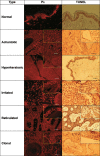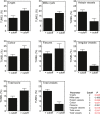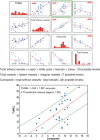Apoptosis in seborrheic keratoses: an open door to a new dermoscopic score
- PMID: 22404841
- PMCID: PMC3494979
- DOI: 10.1111/j.1582-4934.2012.01558.x
Apoptosis in seborrheic keratoses: an open door to a new dermoscopic score
Abstract
The aetiology of seborrheic keratoses (SK), the most common benign epithelial tumours, and any relationship with malignancy are not yet known. As a protective anti-cancer mechanism, apoptosis reflects cellular loss as a reaction to proliferative activity. The objective of this study was to quantify apoptosis in different SK types (acanthotic, hyperkeratotic, reticulated, irritated and clonal) and correlate the dermoscopic picture with apoptosis rate. After a qualitative and quantitative analysis of dermoscopic images, we defined a new quantitative dermoscopic score (C3V2F, crypts, millia cysts, colours, hairpin vessels, irregular vessels, fissures) from 0 to 22, which enabled us to establish cut-offs correlating with apoptosis rates. All five SK forms were associated with lower apoptosis rates compared with normal skin. A C3V2F score >10 and greater number of crypts and colours reflected a higher apoptosis rate, which implies a benign character of evolution. In contrast, the presence of irregular vessels on more than 50% of the lesion surface implied a lower rate of apoptosis and probably associated with a risk of malignant transformation. On the basis of dermoscopic information, we used multiple regression to establish a model for estimating the rate of apoptosis with a 0.7 prediction interval (approximately 1S.D.). The new C3V2F score could be valuable for the clinical evaluation of possible SK prognosis and decisions regarding excision.
© 2012 The Authors Journal of Cellular and Molecular Medicine © 2012 Foundation for Cellular and Molecular Medicine/Blackwell Publishing Ltd.
Figures





Similar articles
-
Dermoscopic Clues for Diagnosing Melanomas That Resemble Seborrheic Keratosis.JAMA Dermatol. 2017 Jun 1;153(6):544-551. doi: 10.1001/jamadermatol.2017.0129. JAMA Dermatol. 2017. PMID: 28355453 Free PMC article.
-
Spectrum of seborrheic keratoses in South Indians: a clinical and dermoscopic study.Indian J Dermatol Venereol Leprol. 2011 Jul-Aug;77(4):483-8. doi: 10.4103/0378-6323.82408. Indian J Dermatol Venereol Leprol. 2011. PMID: 21727696 Clinical Trial.
-
Evaluation of dermoscopic algorithm for seborrhoeic keratosis: a prospective study in 412 patients.J Eur Acad Dermatol Venereol. 2014 Jul;28(7):957-62. doi: 10.1111/jdv.12241. Epub 2013 Aug 24. J Eur Acad Dermatol Venereol. 2014. PMID: 23980820
-
Dermoscopy-pathology relationship in seborrheic keratosis.J Dermatol. 2017 May;44(5):518-524. doi: 10.1111/1346-8138.13657. J Dermatol. 2017. PMID: 28447350 Review.
-
Seborrheic keratosis-like melanoma: a diagnostic challenge.Melanoma Res. 2021 Oct 1;31(5):407-412. doi: 10.1097/CMR.0000000000000756. Melanoma Res. 2021. PMID: 34132226 Review.
Cited by
-
Patient Preferences and Comparative Outcomes Regarding Cryosurgery versus Electrodesiccation in the Removal of Truncal Seborrheic Keratoses.J Clin Aesthet Dermatol. 2019 Sep;12(9):E53-E56. Epub 2019 Sep 1. J Clin Aesthet Dermatol. 2019. PMID: 31641420 Free PMC article.
-
Usefulness of Dermoscopy to Provide Accurate Assessment of Skin Cancers.Clin Cosmet Investig Dermatol. 2021 Jun 29;14:733-746. doi: 10.2147/CCID.S305924. eCollection 2021. Clin Cosmet Investig Dermatol. 2021. PMID: 34234499 Free PMC article.
References
-
- Thomas VD, Swanson NA, Lee KK. Benign epithelial tumours, hamartomas, and hyperplasias. In: Wolff K, Goldsmith LA, Katz SI, editors. Fitzpatrick's dermatology in general medicine. New York, USA: McGraw-Hill; 2008. pp. 1054–7.
-
- Cockerell CJ, Larsen F. Benign epidermal tumours and proliferations. In: Bolognia JL, Jorizzo JL, Rapini RP, editors. Dermatology. Mosby: Elsevier; 2008. pp. 1661–4.
-
- Blotch PH. Transformation of seborrheic keratosis into Bowen's disease. J Cutan Pathol. 1978;5:361–7. - PubMed
-
- Monteagudo JC, Jorda E, Terencio C, et al. Squamous cell carcinoma in situ (Bowen's disease) arising in seborrheic keratosis: three lesions in two patients. J Cutan Pathol. 1989;16:348–52. - PubMed
-
- Lindelöf B, Sigurgeirsson B, Melander S. Seborrheic keratoses and cancer. J Am Acad Dermatol. 1992;26:947–50. - PubMed
Publication types
MeSH terms
LinkOut - more resources
Full Text Sources
Other Literature Sources
Research Materials

